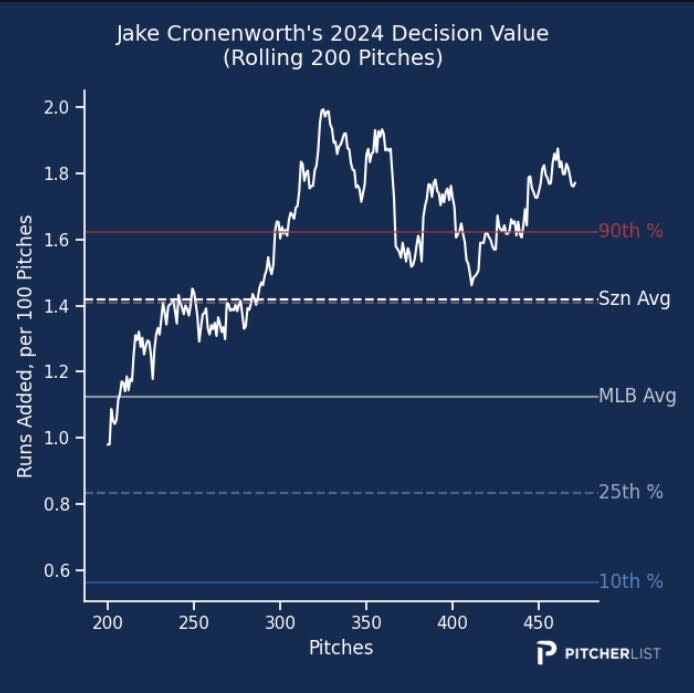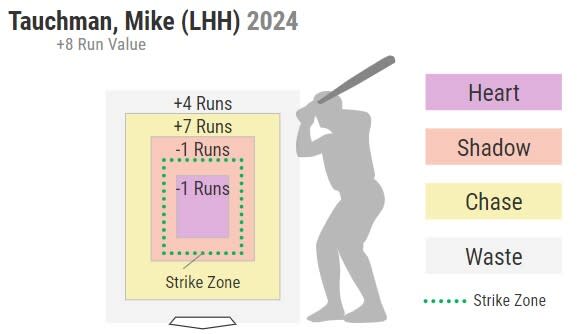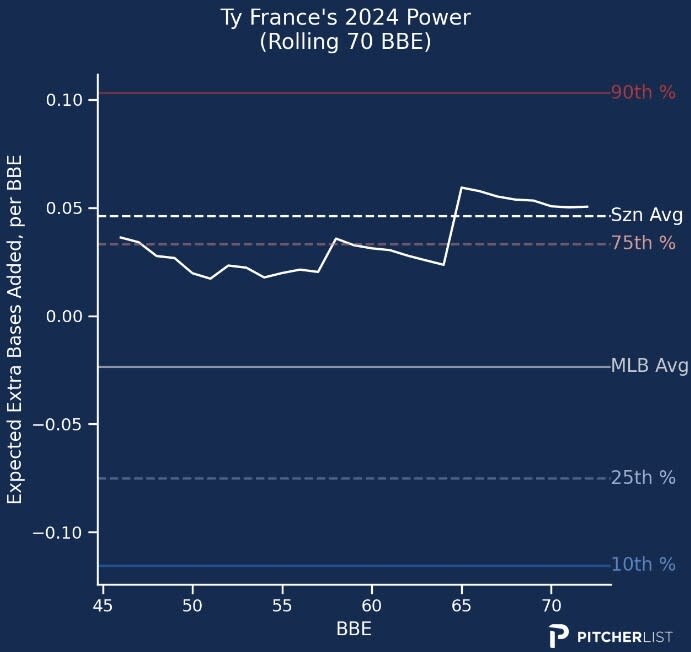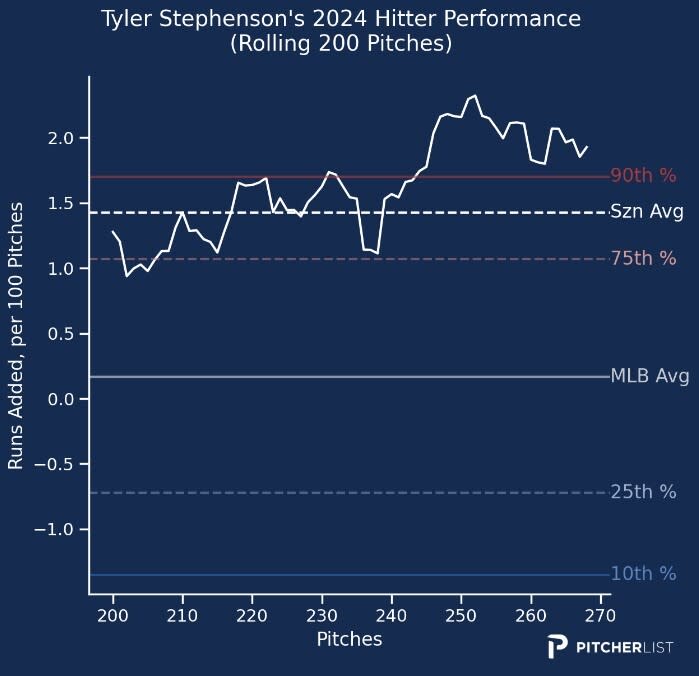Fantasy baseball hitter trade targets for May
We're now over a month into the 2024 fantasy baseball season, so we're starting to see stats stabilize and performances become a little more "real." While players could still fall apart (hello 2023 Jorge Mateo and Matt Chapman) we have a much better sense of who might not be a flash in the pan.
As a result, I think this is often the best time to not just look at hitters who have produced at elite levels but also hitters whose process is clearly improved and should have better performance on the horizon. To do that, I created a custom leaderboard on FanGraphs of some of my favorite process-oriented stats. I then found the league average marks in all of the categories and removed any hitter who wasn't better than the league average in each one, leaving us with a list of hitters who have been above average in my favorite hitter stats, regardless of their surface-level results.
The stats I chose for this leaderboard are barrel rate, max exit velocity, swinging strike rate, overall contact rate, and O-Swing% (or chase rate). To me, these are the most important stats when looking at a hitter's process because we can see who is forcing pitchers to throw them pitches in the strike zone, who is doing a good job of making contact on those pitches, and who is making authoritative contact when they do swing. All of that should line up to produce hitters more likely to give you solid results.
In total, 40 hitters qualified for the leaderboard, so below I'll discuss some of the ones I think will be the easiest to acquire in most leagues, whether through trade or on the waiver wire. All roster rates below are in Yahoo formats as of Wednesday, May 1st.
Evan Carter - OF, Texas Rangers (92% rostered)
You might look at this and immediately think "How can I get Evan Carter?" I would just reply that there is always value in checking in with teams in your league to see who they're willing to move. We may have missed the buying window on Evan Carter because he's 8-for-24 with three home runs, five runs, five RBI, and one steal over the last few games. However, he's also hitting just .220 on the season, so you might have a manager in your league who thinks they're not getting the value they expected out of Carter and wants to move on.
Carter's chase rate is up almost 10% this year, but it's still just 23%, which is better than the league average. He's simply being more aggressive overall as a hitter so while the swing decisions haven't all been great, I'm not overly worried about that increase because I think he's just finding his approach. His swinging strike rate is down to just 8% and both his contact rate and zone contact rates are way up. He's barreling the ball less overall, but that might have to do with him using the whole field more this year and also hitting more fly balls, which has also led to more pop-ups. Considering Carter is not an elite exit velocity hitter, I don't mind that he's using the whole field more because I think that's a better approach for him overall. I'm expecting his .238 BABIP to adjust to the norm, and I think we're still going to get some solid production out of Carter the rest of the way.
Jake Cronenworth - 1B/2B, San Diego Padres (64% rostered)
Jake Cronenworth has been surprisingly good this season, hitting .263 with four home runs, 16 runs scored, and 20 RBI in 30 games. However, he's also 30 years old and most people think they know who he is by this point, so you might have people looking to "sell high" on Cronenworth. While I wouldn't advise you to pay a pretty penny to get him, I think we're seeing some interesting evolution from Cronenworth.
For starters. he's hitting the ball much harder this year with an 11% barrel rate and a 90 mph average exit velocity that are both well above his career averages. He's not pulling or lifting the ball more, so I think the added thump is coming from a more selective approach at the plate. Cronenworth is swinging outside of the zone 6% less than last year and continuing to make elite contact in the zone and elite swing decisions.

In addition to his better swing decisions, Cronenworth is likely also making harder contact due to changing his batting stance in the offseason and adding “ten pounds of muscle." In the linked article from the San Diego Tribune, Cronenworth mentions his new stance being more upright with his elbows higher up, closer to his shoulder line, rather than hanging low by his sides. The thought process was that the change allowed him to be more consistent with his bat path and also be more effective against pitches high in the zone, which is good because he's being pitched up more.
More than anything, Cronenworth also discusses that: "I just realized I know what kind of player I am and I need to get back to doing that and having a similar approach and going up there to just have a quality at-bat." So far so good on that front.
Mike Tauchman - OF, Chicago Cubs (17% rostered)
I will never read Tauchman's name without thinking of Alex Chamberlain, who wrote the Definitive Mike Tauchman Hype Post back in 2019. While Tauchman flashed a bit of fantasy usefulness in the COVID-shortened 2020 season, it really wasn't until last year in Chicago that we saw glimmers of what Alex was writing about. Now, with both Seiya Suzuki and Cody Bellinger on the IL, Tauchman is getting a chance to play regularly again and is running with it.
His swing decisions have been tremendous, with his career's lowest strikeout rate and highest walk rate. He's being a touch more aggressive overall, even swinging at more pitches outside of the strike zone, but he's not really swinging and missing more and he's taking fewer called strikes, so this seems like a controlled aggression that's working for him, which you can see by his +7 Run-Value on pitches in the "Chase" Zone.

Now, this approach is leading to success for Tauchman overall, but it's probably not going to lead to much power. He's pulling the ball over 7% less than last year but is driving the ball into the gaps more because he's using the whole field. In fact, all three of his home runs this year and three of his doubles have been to left-center field. He has just one double to right-center, which is his pull-side power alley. Considering Tauchman is making harder contact overall and seeing a major bump in his batting average, I think it's safe to say the approach is working for him, even if it will not lead to much consistent value in home runs.
Ty France - 1B, Seattle Mariners (12% rostered)
I've been banging the drum about Ty France's exit velocity gains for weeks, and I continue waiting for the power to show up in games. But I'm like Vince Vaughn in "Old School" and I will still be holding here. France's barrel rate is the highest of his career. His 46% Ideal Contact Rate (ICR) is 83rd percentile in baseball. His EV50, which takes the average exit velocity of the top 50% of a hitter’s batted balls, is equal to Mike Trout, Christopher Morel, and Tyler O'Neill. Any way you slice it, the dude is hitting the ball hard.

The issue is that he has just a 25% pull rate and a 25% flyball rate. That's not going to fly if we're looking for power. Now, his exit velocity on flyballs and line drives is at a career-high and his HR/FB rate is at a career-high, so if we can just get France to start pulling the ball, the home runs should start to come. Considering he has a 37% career pull rate, I can't see this 25% mark sticking around for too long. I'm willing to roster France because he's hitting the ball hard and batting .253 while playing every day, so nothing he's doing right now is hurting you but I think there's an easy path forward to see how he can start really helping you.
Josh Rojas - 3B, Seattle Mariners (6% rostered)
Oh, look, another Alex Chamberlain favorite. Rojas was solid for the Diamondbacks in 2021 and 2022 but took a step back last year before being traded to Seattle. He was kind of an afterthought in drafts this year since it was unclear how Seattle would approach their infield situation. However, not only has Rojas emerged as the everyday third baseman, but he's also been hitting leadoff with J.P. Crawford on the injured list.
Like many hitters on this list, Rojas is sporting a career-high walk rate and a career-low strikeout rate. He's chasing outside of the zone at a career-low rate, making contact at a career-high rate, and registering a career-best 7.7% SwStr%. All told, Rojas' more selective approach this season has led to career-bests across the board. Since plate discipline metrics have long since started to stabilize, I think it's pretty clear that we're seeing a new approach from Rojas, and his .313 batting average and 9% barrel rate will give him no reason to change it.
Rojas has adjusted his launch angle slightly, raising it over three degrees, which has led to far more line drives instead of groundballs. That's ideal for a hitter who doesn't have elite power but also doesn't have the speed to consistently beat out grounders (he shockingly has just 40th percentile sprint speed). One thing to keep in mind here is that pitchers have just been challenging Rojas, perhaps because he was hitting at the bottom of the Mariners' lineup. So far this season, he's seeing more pitches middle than ever before and has seen 8.3% of pitches that Pitcher List categorizes as "middle-middle." That's notable above the league average 6.6% rate per hitter. If pitchers start to pitch around Rojas or try and get him to chase more, how will he adjust? That's the big question but as a lead-off hitter so far this year, he's hitting .313 in five games with four walks and two strikeouts, so he hasn't given in so far.
Ryan Jeffers - C, Minnesota Twins (58% rostered)
Tyler Stephenson - C, Cincinnati Reds (10% rostered)
Austin Wells - C, New York Yankees (3% rostered)
We'll end with a few catchers I think you can add or trade for if your catcher is struggling. Jeffers has been the best of the bunch and that's why his roster rate is so high. He's playing basically every day in Minnesota now at either catcher or DH since their lineup is banged-up (and not particularly good), and so that gives him a lot more value than most catchers. He has always had good power and while his barrel rate is actually down this year, he's being more selective at the plate and pulling the ball more, so his contact rates are up and that's led to the boost in batting average. My concern here is that his exit velocity on flyballs and line drives is just 80.5 mph, which is his worst by far and over 8 mph lower than his career average. If that doesn't tick up, I think that will cap some of his power upside.
I also think it's time to buy back into Tyler Stephenson. Injuries have hampered him in the past, and he's currently sitting out a few games after being hit on the hand, so injuries may always be an issue here, but we're starting to see signs of the hitter we thought he could be too. The batting average hasn't quite caught up yet, but Stephenson has a 20% barrel rate, 47% ICR, and exit velocity on flyballs and line drives of 95 mph, which is well above the league average. He's also chasing less, swinging less overall, and making elite contact with a 92% zone contact rate and minuscule 6.6% SwStr%. We love to see that he's pulling the ball more, but he's hitting nearly 60% groundballs, which is less than ideal. If he can get that closer to his 49% career groundball rate, we could see a breakout coming for Stephenson.

Lastly, Austin Wells has been incredibly unlucky so far. He's hitting .196 with a .294 SLG but has a .230 xBA and a .402 xSLG. He has a 13.6% barrel rate, 37% ICR, and an exit velocity on flyballs and line drives of 90 mph, which is above league average. He's being more selective this year, chasing less out of the zone but also swinging 10% less overall. That's led to a slightly higher called strike rate but an 81% zone contact rate and 12% SwStr%, which is much better than last year and has led to just a 14% strikeout rate. He's pulling the ball more and lifting the ball more and is a left-handed hitter in Yankee Stadium. All of this makes me think that we could see a really strong second half for Austin Wells, and I'd be trying to scoop him in two-catcher formats right now.
I'll also end by just mentioning three platoon-bats who fit the same profile. All of Joc Pederson - 1B/OF, Arizona (5% rostered), Lamonte Wade Jr. - 1B/OF, San Francisco (8% rostered), and Gavin Sheets - 1B/OF, Chicago White Sox (5% rostered) made the leaderboard. The issue with all of them is that they won't play against left-handed pitching, which can limit their usefulness in weekly lineup lock leagues since you won't be able to play them in weeks where they're set to face two or more lefties. Sheets has the lowest barrel rate at 7.5% but all of them have SwStr% under 10%, overall contact rates over 76%, and walk rates of 11% or better. We know they can each drive the ball out of the yard, and so these are all names I'd keep on my radar in weekly lineups leagues to try and target when they have a good schedule coming up.
